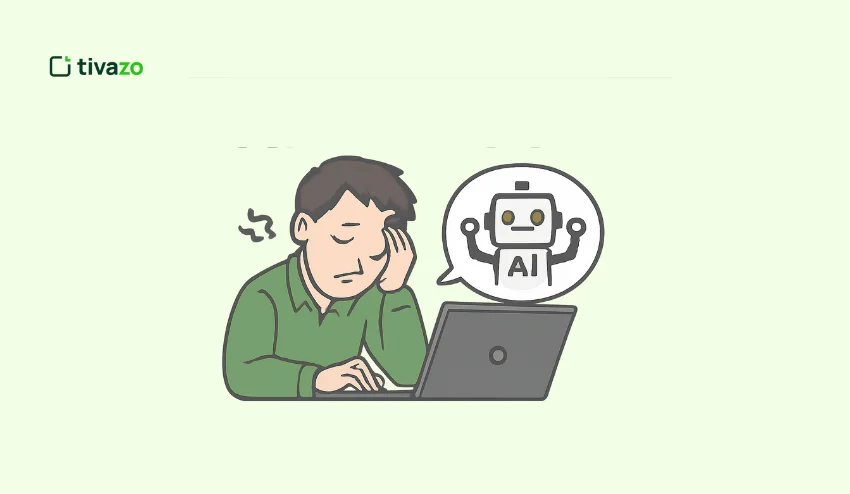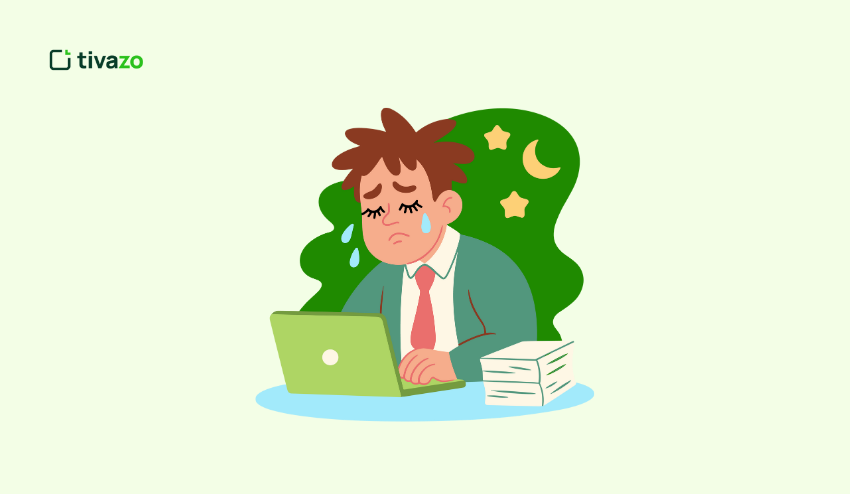As businesses continue to quickly integrate artificial intelligence (AI) technology into the workflow, one problem has quickly come to the forefront—the problem of AI fatigue. When artificial intelligence technology was first introduced to the workplace environment, one problem that this technology solved was that of fatigue among employees. Employees became fatigued due to various tasks that demanded their attention and focus.
But what is the importance of AI fatigue? The need to stay abreast with the latest advancements in AI technology, besides the understanding that needs to be gained to run these technologies efficiently, has generated a newer problem in the workplace. In this blog post, we will discuss the implications that are caused due to AI fatigue in businesses and, more importantly, 5 key ways to counter it.
Key Highlights:
- Rise of AI in the Workplace
- Causes of AI Fatigue
- Recognizing the Symptoms of AI Fatigue
- How AI Fatigue Impacts the Workplace
- Technology Solutions to Address AI Fatigue
- Overcoming AI Fatigue
- Differences Between AI Fatigue and Traditional Workplace Burnout
- Future of AI and Employee Wellness
The Rise of AI in the Workplace
1. How AI Tools Have Evolved
The past decade has seen tremendous growth in AI technology from niche use cases within technology firms to mainstream adoption within every sector. From customer service assistants to data-driven decision platforms, AI technology has found mainstream use within our operations to automate tasks and enable businesses to make better decisions.
But the adoption of AI has led to one surprising effect AI fatigue. Employees who previously welcomed AI to improve productivity are instead struggling to keep up with the demands that these technologies are placing upon them.
2. The Pressure to Adopt AI
In today’s scramble to be more agile and stay ahead in the market, firms are racing to implement artificial intelligence without thinking about its aftereffects on employees. The need to stay ahead in the curve to fully exploit this technology leaves employees overworked and leads to burnout. This trend is set to go as AI technology accelerates exponentially.
3. AI Fatigue Statistics
A survey conducted recently by Quantum Workplace has found that employees who use AI extensively in their day-to-day work are more likely to experience burnout in their job compared to those who use AI less frequently, or never use AI. In fact, 45% of those who use AI frequently reported that they are experiencing burnout compared to 38% who use AI infrequently.
Causes of AI Fatigue
AI fatigue has mostly been fueled by various factors that trace their origins to the way these technologies are designed and developed. These factors include the usability challenges that come with the endless flow of information that one has to cope with. Below are the factors that lead to AI fatigue:
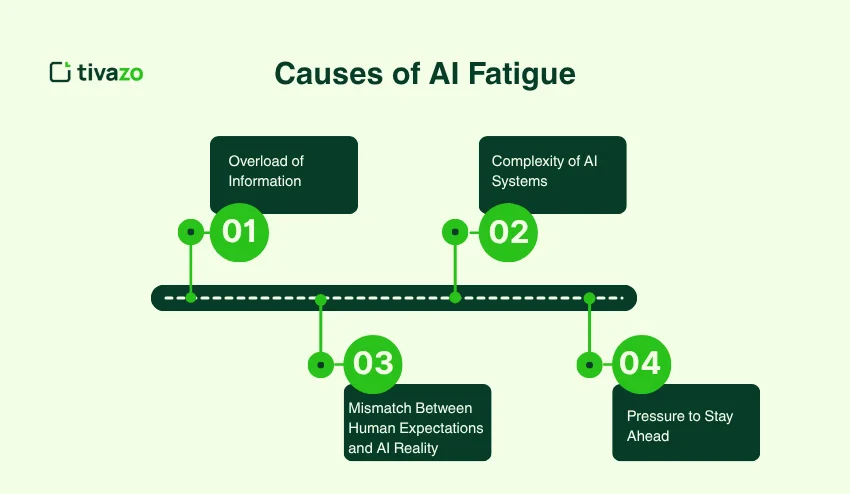
1. Overload of Information
One of the key reasons that contributes to AI fatigue is the amount of data generated and notifications received from AI applications. Whether it is updates about performance data or notifications from AI-powered customer service applications, employees can be swamped with the amount of data that is being pushed to them.
2. Complexity of AI Systems
As the technology gets more advanced, the more complex it becomes. The workforce must be familiar with and use more and more complex technology to complete tasks. This has led to cognitive overload. The fact that the workforce must continually be trained in new technology that has AI features adds to fatigue.
3. Mismatch Between Human Expectations and AI Reality
Many businesses are eager to integrate AI tools with the intention that these will greatly boost productivity. But if such AI technologies do not work as expected and need more human input than was anticipated, then frustration begins to set in.
4. Pressure to Stay Ahead
The area of artificial intelligence is constantly moving forward, and the need to be current with the latest developments can be daunting. The sense that one has to be constantly in catch-up mode leads to one feeling perpetually pressured.
Recognizing the Symptoms of AI Fatigue
AI fatigue can impact employees in different ways. The impact may be psychological as well as physical. Early detection of these signs is essential to prevent further complications such as burnout and poor job performance. The following are some signs that might indicate your employees are experiencing AI fatigue:
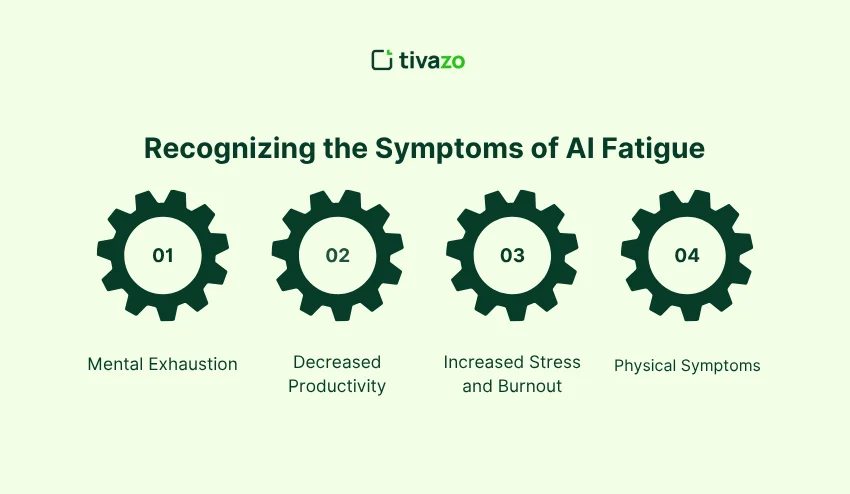
1. Mental Exhaustion
The perpetual need to engage one’s mind with the AI technology can lead to drained employees. They might be unable to focus or experience decision fatigue, which contributes to lower productivity and job satisfaction among them.
2. Decreased Productivity
As AI fatigue becomes more prevalent within the workplace, this leads to lower productivity among employees. Many employees find that tasks that previously seemed manageable suddenly appear daunting, making it difficult to complete these tasks within the required time and to the usual standard.
3. Increased Stress and Burnout
One of the most pronounced results that come from AI fatigue is stress caused by AI. When employees are overburdened with work, stress sets in, which leads to burnout. Not only does this impact employees’ work but also affects them as people.
4. Physical Symptoms
In addition, Mental and emotional side effects are not the only possible consequences that employees can develop. Employees can also experience physical side effects such as headaches, eye strain, and musculoskeletal discomfort from the continued use of AI technology.
How AI Fatigue Impacts the Workplace
Employee fatigue affects the health and productivity of the organization, not just employee morale. Mental and physical exhaustion experienced from working with AI for most of the day leads to decreased performance on behalf of employees. Here are ways fatigue from AI interaction impacts the organization:
1. Declining Employee Morale
Employees can face feelings of being overwhelmed and overworked from new management of AI via their job position, which often leads to decreased employee morale. Employees may feel disconnected from their jobs and/or lack motivation for their work resulting in disengagement or even an unhappy workplace. Additionally, employee morale affects the overall company culture and productivity.
2. Loss of Innovation and Creativity
Working to sort through the responsibilities and accomplish the tasks attributed to the use of AI leads to overstimulation, thus sinking creativity and innovative thinking. The fatigue experienced does not lead to brainstorming, experimenting with new ideas, or developing creative plans for resolving problems because employees are consumed with managing and sorting through heavy workloads.
3. High Turnover Rates
AI fatigue can also lead to higher employee turnover. Employees that now feel overworked and overwhelmed with their responsibilities are more likely to seek other opportunities and leave their job, thus raising recruiting and training costs for employers.
Building a Supportive Work Environment to Combat AI Fatigue
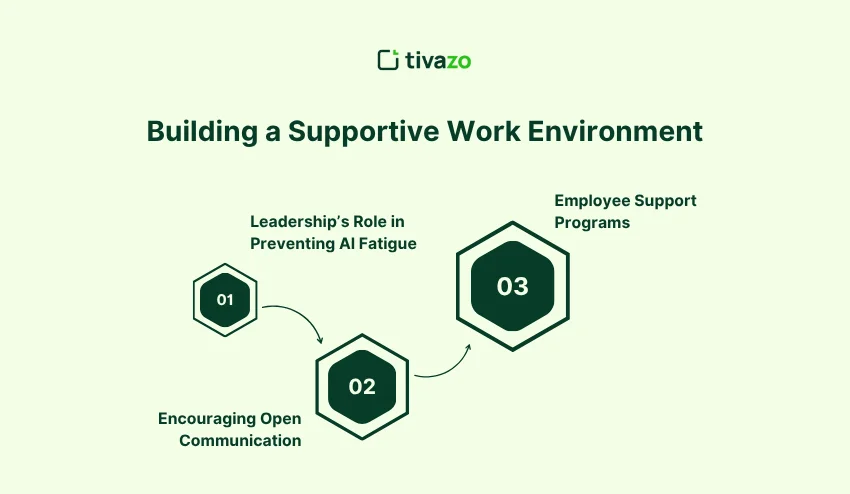
1. Leadership’s Role in Preventing AI Fatigue
Leaders play an important role in helping employees avoid AI fatigue. Setting the right expectations, training employees continually, and communicating with them are key to creating an environment that will enable employees to use AI.
2. Encouraging Open Communication
Permitting employees to share experiences about the difficulties that come with working with AI technology provides them with the opportunity to freely communicate how they feel. Employees can then start addressing AI fatigue with the aid of these options.
3. Employee Support Programs
Investing in employee wellness programs that focus on the mental and physical impact of working on AI-based tools is necessary. Providing stress tools, counseling, and a few breaks will employees return to a more productive state after AI fatigue
Technology Solutions to Address AI Fatigue
While reducing AI fatigue may contain more than simply taking more breaks, it is critical to think about leveraging technology that can promote both productivity and employee well-being. There are a number of effective AI solutions which can reduce fatigue, enhance workflows, and streamline the person’s overall user experience. Some technology solutions to explore:
1. AI Tools That Help Combat Fatigue
There are in fact AI tools that are developed with a focus on supporting employee mental health and fatigue. As an example, there are some wellness applications driven by AI that allow individuals to track their mental health and well-being, and productivity tools that assist in automating repetitive tasks, allowing for additional creativity and time for more meaningful work.
2. Streamlining AI Integration
AI tools can be made less overwhelming by streamlining their use. Firms should consider adopting user-friendly AI technologies that are conducive to integration into other existing systems. In doing so, employees are likely less intimidated and find using the technologies easier.
3. Personalization of AI Tools
Firms can also implement personalized or flexible use of AI tools to improve the overall workplace environment. Personalization or individualization of AI tools helps to alleviate the cognitive load of using them. In real-world usage, customization of AI systems allows individuals to leverage the technology in a manner that is most intuitive and functional for each user.
Overcoming AI Fatigue: 5 Proven Strategies
Managing AI fatigue requires a thoughtful, holistic approach to managing technology in the workplace. Employing the following five strategies will help businesses to mitigate stress, increase productivity, and keep employees engaged. Here’s how to deal with AI fatigue:

- Set Clear Boundaries with AI Tools
Restrict the amount of time spent engaged with AI tools during each workday to prevent cognitive overload. Provide the option for employees to disconnect from technology regularly. - Encourage Regular Breaks
Support employees in taking breaks during the day to rest and recharge. Small activities, including stretching, physical movement or simply stepping away from their workspace, can lower stress and increase focus and productivity. - Invest in Training and Support
Continual training for employees on the use of AI will help them to feel confident about their use of AI tools. In periods of uncertainty related to the content of AI, access to a knowledgeable technical resource can remove frustration for employees. - Promote Work-Life Balance
As much as AI may be pushing to improve speed or responsiveness, supporting a healthy lifestyle and work-life balance for employees. Healthy life habits can minimize stress and maintain productivity. - Foster a Positive Work Culture
Present AI as an opportunity to affect team collaboration, productivity and relationships rather than an added burden or control on their productivity.
Differences Between AI Fatigue and Traditional Workplace Burnout
While AI exhaustion and traditional workplace burnout involve both mental and physical exhaustion, the causes and results differ significantly. Understanding these differences can help companies create an individualized approach to support both issues. See below for comparison to delineate how AI exhaustion impacts employees significantly differently than traditional burnout.
| Aspect | AI Fatigue | Traditional Workplace Burnout |
|---|---|---|
| Primary Cause | Overload from constant interaction with AI tools, constant updates, and AI-related tasks. | Prolonged work pressure, overwhelming workloads, and lack of rest. |
| Symptoms | Mental exhaustion, stress from AI complexity, frustration with unmet AI expectations, and physical strain from prolonged screen time. | Emotional exhaustion, depersonalization, and reduced personal accomplishment. |
| Impact on Productivity | Decreased focus and decision fatigue due to constant AI tool engagement. | Decreased performance due to emotional and physical exhaustion. |
| Cognitive Load | High cognitive demand due to managing complex AI tools and processing vast amounts of data. | Cognitive overload from dealing with unmanageable tasks and deadlines. |
| Physical Effects | Eye strain, headaches, and general fatigue from excessive screen time and multitasking with AI tools. | Fatigue, sleep disturbances, and physical symptoms caused by constant stress. |
Practical Steps to Manage and Prevent AI Fatigue in Your Organization
Let it be known that the first step in removing AI fatigue is to limit the utilization of AI tools as well as to establish boundaries in a concise manner to avoid the situation where the workload becomes too much. Always remind workers to take breaks to facilitate the process of recharging their brains and, at the same time, preventing mental fatigue. Proper training will help in getting the staff to a point where they can use the AI systems with support, hence minimizing the frustration caused by lack of training.
On top of that, the provision of mental well-being support and the supplying of stress-relief resources will be beneficial for the workers as they will be able to get used to the AI demands with ease.
The Future of AI and Employee Wellness in 2026
1. Emerging Trends in AI Fatigue Prevention
No stopping the emergence of the preventive measures against the AI overload as the technology develops; rather, the approach to AI fatigue through employee wellness program becomes more evident as AI-evolving companies are creating and providing their staff with AI-empowered solutions preventing even the slightest exhaustions such as wellness applications or management tools based on AI intelligence.
2. AI-Driven Solutions to AI Fatigue
AI can be applied in such a way that it would benefit humans and lessen their fatigue. It can do such by taking over dull and monotonous tasks, besides, providing staff with problems of stress management according to their needs, thus, making the workplace healthier.
3. How Businesses Can Prepare for 2026
Boasting a very sustainable and friendly to the employees AI-practice will be one of the major things that the business will have to do while looking at the future. To win the challenges of 2026 companies can offer cognitive overload-reducing tools and create a reinforcing work culture in the first place.
Conclusion: Managing AI Fatigue for a Healthier Future
AI fatigue is becoming a more and more common problem but it can still be managed and even turned into a good thing. Once companies identify the causes and the signs of the tiredness triggered by AI and also adopt suitable tactics, the workers will not only be the case of the companies but they will also be the companies themselves.
Take the first steps with little alterations in your office to eliminate AI fatigue. Keep in mind that the objective is to be efficient rather than just working hard and to establish a place where both machines and humans can perform their best.
